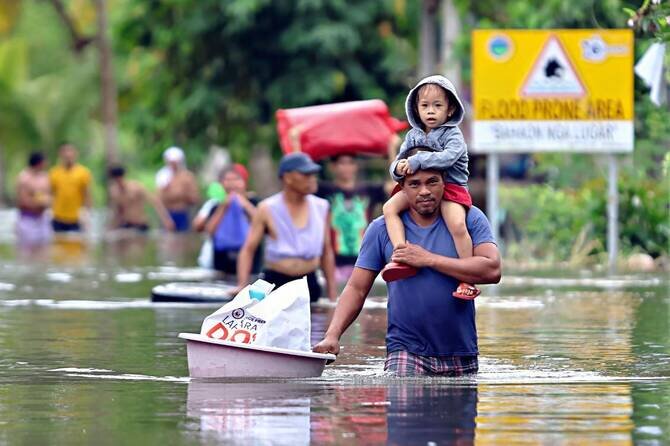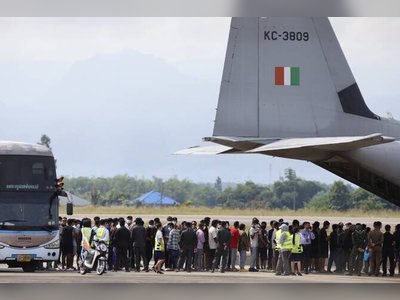
Super Typhoon Fung-wong Threatens Philippines with Massive Evacuation
Fung-wong, categorized as the biggest storm to threaten the Philippines this year, is expected to make landfall on Sunday or early Monday.
Super Typhoon Fung-wong, classified by the Philippines as the largest storm to threaten the country in 2023, initiated its assault on the Philippines' northeastern coast ahead of landfall on Sunday.
The incursion has resulted in the displacement of nearly one million individuals, while authorities have urged inhabitants of high-risk communities to evacuate before it's too late.
Fung-wong, known locally as Uwan, is forecasted to span a vast area across the Southeast Asian archipelago due to its expansive rain and wind field measuring approximately 1,600 kilometers in width.
As it approaches from the Pacific Ocean, Fung-wong poses an additional challenge to the Philippines still reeling from Typhoon Kalmaegi's devastation that claimed over 200 lives and inflicted widespread destruction across central island provinces.
Philippine President Ferdinand Marcos Jr. declared a state of emergency, acknowledging both the aftermath of Kalmaegi and the imminent threat posed by Fung-wong.
The typhoon is expected to make landfall in Aurora or Isabela province later on Sunday or early Monday, according to government forecasters.
Fung-wong's wind speeds have been measured at up to 185 kilometers per hour (115 mph) with gusts reaching as high as 230 kilometers per hour (143 mph), earning it the designation of a 'super typhoon' in the Philippines.
Over 916,860 individuals have been evacuated from areas deemed vulnerable to Fung-wong's fury, primarily focusing on regions susceptible to Pacific cyclones and mudslides.
Defense Secretary Gilberto Teodoro Jr., overseeing the country’s disaster response efforts, has expressed concern over the potential catastrophic impact of the storm, emphasizing its reach could extend towards Cebu — one of the hardest-hit areas by Typhoon Kalmaegi — as well as the densely populated capital region around Manila.
With a potential exposure of over 30 million individuals to hazardous conditions, the Office of Civil Defense has issued grave warnings.
Secretary Teodoro stressed the urgency in relocating populations from flood-prone, landslide-sensitive zones and coastal areas susceptible to tidal surges, noting that immediate action is crucial as it becomes increasingly difficult to conduct rescues once the storm hits and flooding sets in.
Although international aid has not yet been requested following Typhoon Kalmaegi's destruction, the United States and Japan stand ready to provide assistance.
In preparation for Fung-wong’s arrival, several eastern towns have lost power, and authorities have preemptively shut down schools and most government services in anticipation of Monday and Tuesday.
Over 325 domestic and 61 international flights have been canceled, leaving more than 6,600 commuters and cargo workers stranded at sea due to prohibitions on venturing into rough waters.
The Philippines is known for being among the world's most disaster-prone countries, regularly facing approximately 20 typhoons and storms annually, alongside numerous earthquakes and active volcanoes.
This makes the population continuously vulnerable to natural calamities of such magnitude.
The incursion has resulted in the displacement of nearly one million individuals, while authorities have urged inhabitants of high-risk communities to evacuate before it's too late.
Fung-wong, known locally as Uwan, is forecasted to span a vast area across the Southeast Asian archipelago due to its expansive rain and wind field measuring approximately 1,600 kilometers in width.
As it approaches from the Pacific Ocean, Fung-wong poses an additional challenge to the Philippines still reeling from Typhoon Kalmaegi's devastation that claimed over 200 lives and inflicted widespread destruction across central island provinces.
Philippine President Ferdinand Marcos Jr. declared a state of emergency, acknowledging both the aftermath of Kalmaegi and the imminent threat posed by Fung-wong.
The typhoon is expected to make landfall in Aurora or Isabela province later on Sunday or early Monday, according to government forecasters.
Fung-wong's wind speeds have been measured at up to 185 kilometers per hour (115 mph) with gusts reaching as high as 230 kilometers per hour (143 mph), earning it the designation of a 'super typhoon' in the Philippines.
Over 916,860 individuals have been evacuated from areas deemed vulnerable to Fung-wong's fury, primarily focusing on regions susceptible to Pacific cyclones and mudslides.
Defense Secretary Gilberto Teodoro Jr., overseeing the country’s disaster response efforts, has expressed concern over the potential catastrophic impact of the storm, emphasizing its reach could extend towards Cebu — one of the hardest-hit areas by Typhoon Kalmaegi — as well as the densely populated capital region around Manila.
With a potential exposure of over 30 million individuals to hazardous conditions, the Office of Civil Defense has issued grave warnings.
Secretary Teodoro stressed the urgency in relocating populations from flood-prone, landslide-sensitive zones and coastal areas susceptible to tidal surges, noting that immediate action is crucial as it becomes increasingly difficult to conduct rescues once the storm hits and flooding sets in.
Although international aid has not yet been requested following Typhoon Kalmaegi's destruction, the United States and Japan stand ready to provide assistance.
In preparation for Fung-wong’s arrival, several eastern towns have lost power, and authorities have preemptively shut down schools and most government services in anticipation of Monday and Tuesday.
Over 325 domestic and 61 international flights have been canceled, leaving more than 6,600 commuters and cargo workers stranded at sea due to prohibitions on venturing into rough waters.
The Philippines is known for being among the world's most disaster-prone countries, regularly facing approximately 20 typhoons and storms annually, alongside numerous earthquakes and active volcanoes.
This makes the population continuously vulnerable to natural calamities of such magnitude.










